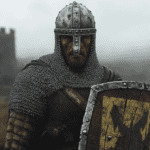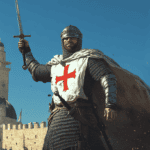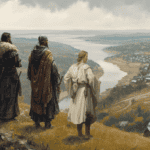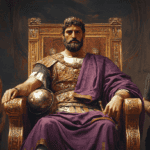
The Prelude: A World in Flux
The Iberian Peninsula, prior to the Muslim invasion, was under the control of the Visigothic Kingdom. The Visigoths, a Germanic people, had established their rule in the region after the fall of the Western Roman Empire. However, by the early 8th century, the Visigothic Kingdom was plagued by internal strife and weakened by civil wars. This internal discord made the region vulnerable to external threats.
In North Africa, the Umayyad Caliphate had been expanding its territories. The governor of Ifriqiya (modern-day Tunisia), Musa ibn Nusayr, had successfully subdued the Berber tribes and extended Umayyad control across North Africa. It was under his command that the initial plans for the invasion of Iberia were formulated.

The Invasion Begins: Tariq ibn Ziyad and the Battle of Guadalete
The first significant military action of the invasion was the landing of a small reconnaissance force in 710 AD, led by Tarif ibn Malik. This initial foray was followed by a larger expedition in 711 AD, commanded by Tariq ibn Ziyad, a Berber general under Musa ibn Nusayr. Tariq’s force, consisting of approximately 7,000 soldiers, crossed the Strait of Gibraltar and landed at a location that would later be named after him, Gibraltar (Jabal Tariq).
The decisive moment came at the Battle of Guadalete, where Tariq’s forces clashed with the army of King Roderic, the last Visigothic ruler. Despite being outnumbered, the Muslim army emerged victorious, thanks to their superior tactics and the element of surprise. Roderic was believed to have been killed, leaving the Visigoths largely leaderless and disorganized. This victory paved the way for further Muslim advances into the heart of Iberia, helped by the fact that the ruling Visigoths are estimated to have made up just just 1 to 2% of the total population, and the Hispano-Roman peasantry had little loyalty to their Visigoth overlords.
The Rapid Expansion: From Gibraltar to the Pyrenees
In 712 AD, Musa ibn Nusayr himself crossed into Iberia with a reinforcement of 18,000 soldiers. Musa and Tariq’s combined forces continued their advance, capturing more territory and consolidating their control over the peninsula. Cities like Córdoba, Seville, and Toledo fell one by one. By 718 AD, the majority of the Iberian Peninsula was under Muslim control, with only a few pockets of Christian resistance remaining in the northern mountainous regions.

The Role of Naval Power
Naval power played a crucial role in the Muslim invasion of Iberia. The initial crossing of the Strait of Gibraltar was made possible by a fleet of ships provided by the Berber allies. The control of key ports and coastal cities allowed the Muslim forces to secure supply lines and reinforce their positions.
The importance of naval power was further demonstrated in the defense against external threats. For instance, in 844 AD, a Viking raid on Seville was repelled by the Muslim forces, who had strengthened their naval capabilities to protect the coast.
The Establishment of Al-Andalus
With the conquest largely complete, the Muslim rulers established the province of Al-Andalus, which became a part of the Umayyad Caliphate. The capital was initially set in Córdoba, which would later become a center of learning and culture. The new rulers implemented a system of governance that allowed for a degree of religious and cultural autonomy for the Christian and Jewish populations, a policy that helped to stabilize the region.
Cultural Flourishing: The Golden Age of Al-Andalus
Under Muslim rule, Al-Andalus experienced a period of remarkable cultural and intellectual flourishing. The city of Córdoba, in particular, became a beacon of knowledge, attracting scholars, poets, and scientists from across the Muslim world and beyond. Libraries, universities, and architectural marvels like the Great Mosque of Córdoba were built, showcasing the sophisticated and diverse culture of Al-Andalus.

The Christian Reconquista: A Gradual Pushback
Despite the initial success of the Muslim conquest, the Christian kingdoms in the north never fully accepted Muslim rule. Over the centuries, they gradually began to push back, a process known as the Reconquista. This effort was marked by periods of intense warfare, strategic alliances, and shifting frontiers.
One of the most significant turning points came in 1085, when Alfonso VI of Castile captured Toledo, a former Visigothic capital. This victory was symbolic and strategic, as it demonstrated that the Christian kingdoms were gaining momentum.
The Fall of Granada: The End of Muslim Rule
The Reconquista reached its climax in the late 15th century. The Emirate of Granada, the last Muslim stronghold in Spain, had managed to survive for centuries despite the gradual Christian reconquest of the peninsula. The Catholic Monarchs, Ferdinand II of Aragon and Isabella I of Castile, were determined to complete the Reconquista. Their marriage in 1469 had unified their kingdoms, providing the necessary resources and political stability to launch a concerted military campaign against Granada.

The war for Granada began in earnest in 1482. The initial phase saw a series of skirmishes and minor battles as the Castilian forces tested the defenses of the Nasrid kingdom. The first major victory came with the capture of Alhama in 1482, a strategic fortress that provided a foothold for further operations. The capture of Alhama demonstrated the effectiveness of the Castilian artillery. The walls of the fortress, once considered impregnable, crumbled under the relentless bombardment. This victory boosted the morale of the Castilian troops and sent a clear message to the Nasrid rulers about the power of the new military technology.
One of the most significant and grueling battles of the campaign was the siege of Málaga in 1487. Málaga was a vital port city and a stronghold of the Nasrid kingdom. Its capture was essential for cutting off supplies and reinforcements to Granada.
The siege of Málaga was a protracted and brutal affair. The Castilian forces, under the command of Ferdinand, surrounded the city and began a relentless bombardment. The defenders, aware of the strategic importance of Málaga, put up a fierce resistance. The siege lasted for several months, with both sides suffering heavy casualties.The turning point came when the Castilian artillery breached the city’s walls, allowing the infantry to storm the city. The fall of Málaga was a devastating blow to the Nasrid kingdom, significantly weakening its defensive capabilities and morale.
With the fall of Málaga, the path to Granada was open. The final phase of the campaign began in 1491, with the Castilian forces laying siege to the city of Granada itself. The siege was a massive undertaking, involving tens of thousands of troops and extensive logistical support.
The Castilian army established a network of camps around Granada, effectively cutting off the city from the outside world. The use of artillery once again proved decisive. The walls of Granada, though formidable, could not withstand the sustained bombardment. The psychological impact of the artillery was also significant, demoralizing the defenders and sapping their will to resist. Inside the city, the situation grew increasingly desperate. Supplies dwindled, and the civilian population suffered from hunger and disease. The Nasrid ruler, Muhammad XII (known as Boabdil), realized that further resistance was futile. On January 2, 1492, he surrendered the city to Ferdinand and Isabella, bringing an end centuries of Muslim rule in Spain.
Legacy and Impact
The Muslim conquest of Iberia and the subsequent centuries of Muslim rule left a profound legacy on the region. The cultural and scientific achievements of Al-Andalus had a lasting impact on European thought and development. The architectural styles, agricultural techniques, and even some aspects of the Spanish language bear the imprint of this period. Moreover, the coexistence of Muslims, Christians, and Jews in Al-Andalus, despite occasional conflicts, created a unique and rich cultural tapestry that continues to fascinate historians and scholars today.




